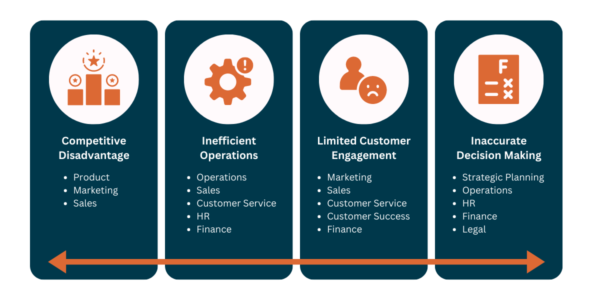
We know that Large Language Models (LLMs) are a way to structure, organize, and understand information. With these capabilities, LLMs can generate new text that appears human-like and assist with various tasks like:
- Writing and conversation
- Code generation
- Validation of outputs
- Information retrieval and parsing of unstructured documents
All of these applications further enhance the user experience by bringing a more natural and effortless interaction with technology resulting in efficient outcomes and positive business impact. At the same time, LLMs could possibly be devastating for individual businesses. Why is that?
ChatGPT summarized the risks of a business ignoring LLMs and its potential business applications:
- Competitive disadvantage: Falling behind technologically advanced competitors
- Inefficient operations: Manual tasks, slower decision-making, and increased costs
- Limited customer engagement: Missed opportunities for personalized experiences and failing to meet evolving customer expectations
- Inaccurate decision-making: Lack of data-driven insights and potential growth opportunities.
LLMs Influence Every Aspect of Business:
Mapping ChatGPT’s corporate jargon to functional business areas brings into focus how LLM inaction, when it comes to implementing them into your business strategy, actually puts a business at risk. LLMs have the potential to impact every aspect of business.
Few technologies, outside of Excel, have had such broad application across business. The cross-functional applications of LLMs mean the LLMs are not limited to a feature or tool. LLMs are a strategic initiative that, when implemented across your organization, will help run and provide insight into ALL areas of your business across all departments. I’ll repeat that one more time: LLMs are not just a tool or feature. LLMs organize and help run your business.
The Risk of Ignoring LLMs:
Yes, there are examples specific to tech where LLMs are shaping up to be category detractors; think text extraction and chatbots. The LLM is likely to be a superior competitor for most of these products and they will inevitably fall by the wayside.
However, it’s the broad business application that explains why failure to evaluate LLMs is inherently risky. Thinking LLM disruption is limited to tech misses the larger disruption to your business. Thinking that the potential for LLMs to disrupt your business is limited to your core product then misses the potential for LLMs to disrupt your product, sales, operations, customer and strategy teams.
LLMs have the potential to disrupt the entire business by outmaneuvering the competition at every level.
Falling Behind on Reporting
For example, most companies today provide online reporting to their customers. The report is not the product, the report simply provides insight into how the customer consumes and values the product. Yet reporting is seen by many consumers, especially in the B2B space, as a key differentiator.LLMs can provide customers with a superior reporting experience by providing a flexible Q&A approach and deeper personalized insights, to name a few.
Limiting Marketing Personalization
The effectiveness of marketing personalization is often limited by the amount of content the marketing team can create. This is why personas that distill a customer into one of a few “types” is so popular today. LLMs don’t need personas — they can incorporate all of the information about a customer and create marketing content on a true 1:1 scale. LLMs are pushing the cost of content creation to zero while still outperforming those businesses that rely on basic demographics or recent transactions.
LLM Opportunity: Where to Get Started?
When a single tool crosses so many functional departments of a business, it can be hard to get started. Furthermore, how does a whole business or functional unit evaluate LLM opportunities if they lack an understanding of what’s possible? Leadership needs a team member who can educate the business on specific opportunities and be accountable to the functional leader for the success of the LLM project.
LLM Education and Low Risk Trial
Today’s LLM-buying conversation often starts with a demo or use case. Conversation can quickly shift to buying, using, and growing LLMs. Unfortunately, the focus on adoption doesn’t meet many businesses where they are today. Without an understanding of safeguards and risks, providing new technology access to sensitive data or licenses to engage with customers is simply too risky for business. Today, businesses need LLM education and a low-risk way to try LLMs. Once educated and validated, your business is in a position to discuss adoption.
How does business leadership get educated on LLM opportunities? One way is to create an LLM innovation goal within the organization. The sole objective of the LLM innovation goal is to identify and educate leadership about high-value LLM opportunities. Identifying the LLM innovation goal should be completed quickly, and the output is documentation and discussion with leadership about the identified opportunities to evaluate where, and if, a low-risk LLM trial is warranted.
Bring LLM Opportunity to Your Organization
LLMs are extremely powerful but need a leader to help wrangle the opportunity and educate the team. Even for this article, asking an LLM about the risk of not exploring LLMs required some human intervention. To be clear, it’s not that a human must review every LLM decision or that the output cannot be trusted. Nor is it that LLMs are too risky for business.
In fact, it’s quite the opposite: If an organization doesn’t assess the opportunity for LLMs to organize information, automate, and provide insight, the business is potentially at risk. Once an opportunity is understood and guardrails are in place, LLMs can be an important tool in an automated workflow.
In the gap between “we should explore LLMs” and “let’s add this LLM to our process tomorrow” is the need for a leader to help educate and guide a business towards its LLM goals. And Stellar is here to help implement and build solutions to achieve them.
